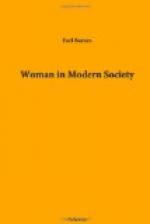[12] HELEN B. THOMPSON, Psychological Norms in Men and Women, p. 171, University of Chicago Press, 1903.
Along with these fixed qualities of action, women have a tendency to indirection when they advance. We say they have diplomacy, tact and coquetry, while man is more direct and bald in his methods. Of course, one easily understands how these qualities may have arisen, since “fraud is the force of weak natures,” and woman has always been driven to supplement her weakness with tact, from the days of Jael and Delilah down to the present day adventuress.
These qualities of mind naturally drive women to literary interests which are concrete, personal and emotional. Men turn more easily than women to the abstract generalizations of science. Of course, there are marked exceptions to these general statements, in both sexes. Madame Curie, who was recently a candidate for the honors of the French Academy, and who, in 1911, was given the Nobel prize for her distinguished services to chemistry, is but one of many women who are famous to-day in the world of science. Still the private life of these women, as in the case of Sonya Kovalevsky, seems to bear out our general conclusion. Men, on the other hand, as milliners and editors of ladies’ journals, show marked skill in catering to women’s tastes; but on the whole the differences indicated seem important and widely diffused.
Another profound difference between men and women is the woman’s greater tendency to periodicity in all her functions and adjustments to life.[13] In all normal societies the life of the man is fairly regular and constant from birth to old age. He moves along lines mainly predetermined by his heredity and his environment, his habits and his work. Even puberty is less disturbing in its effect upon a boy than upon a girl; and often by eighteen we can anticipate the life of a young man with great accuracy. The one element in his life hardest to forecast is the effect of his love-affairs.
[13] See chapter on Periodicity in G. STANLEY HALL’S Adolescence, Vol. I, p. 472.
With a woman, it is quite different. As a girl, the period of puberty produces profound changes; and after that, for more than thirty years she passes through periodical exaltations and depressions that must play a large part in determining her health, happiness and efficiency. In the forties, comes another great change which affects her life to a degree strangely ignored by those who have dealt with her possibilities in the past.[14]
[14] KARIN MICHAELIS, The Dangerous Age, John Lane Co., 1911, is said to have sold 80,000 in six weeks when it first appeared in Berlin. The Bride of the Mistletoe, by JAMES LANE ALLEN (Macmillan), deals with the same period.




